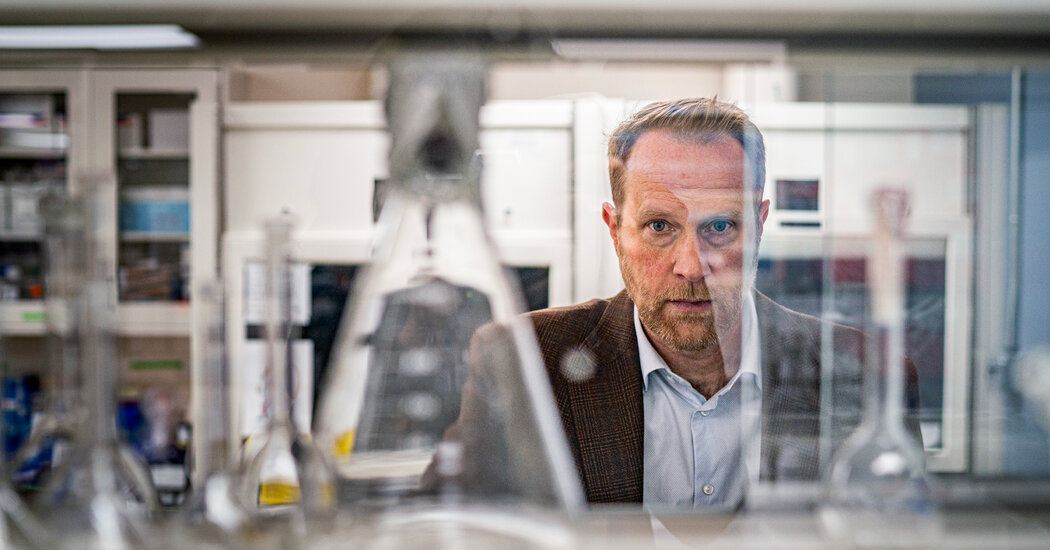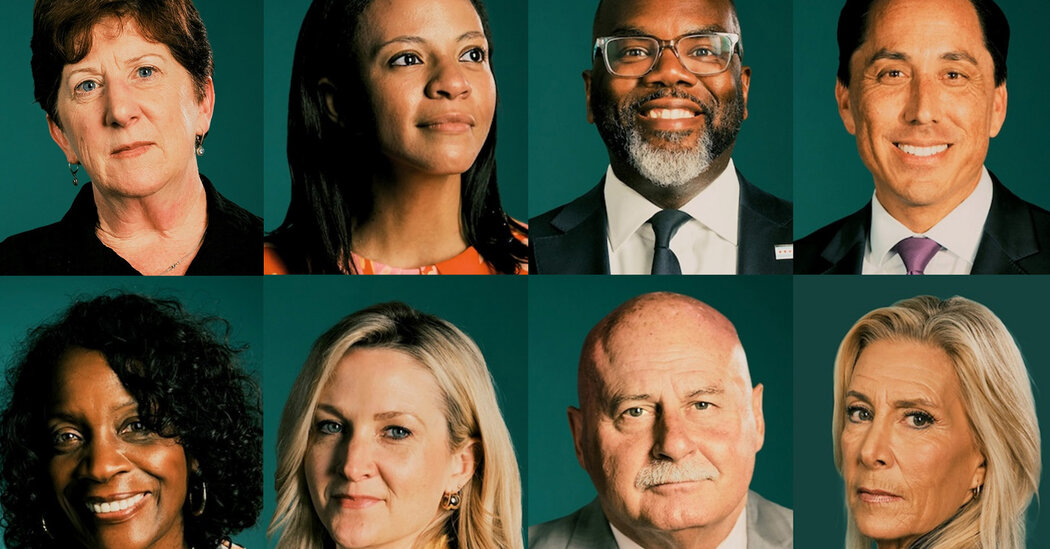In a basement laboratory at the University of New Mexico, Marcus Garcia rummaged through a bin full of plastic waste. He picked past bottles, chunks of fishing net, a toothbrush, a cup with a Pokemon character and a G.I. Joe.
“Yes!” he exclaimed, holding up a discarded pipette tip. “Found it.”
Dr. Garcia, a postdoctoral fellow in pharmaceutical sciences, discovered the pipette tip last summer with colleagues on a remote Hawaii beach. It was miraculously intact though it had most likely been degraded for years by sun, ozone and the ocean. How poignant, he thought. It was an object he and thousands of other scientists used every day. And there it was, washed up on a beach along with hundreds of pounds of other plastic waste they were now cleaning up and collecting for research.
Dr. Garcia is part of a leading lab, run by toxicologist Matthew Campen, that is studying how tiny particles known as microplastics accumulate in our bodies. The researchers’ most recent paper, published in February in Nature Medicine, generated a string of alarmed headlines and buzz in the scientific community: They found that human brain samples from 2024 had nearly 50 percent more microplastics than brain samples from 2016.
“This stuff is increasing in our world exponentially,” Dr. Campen said. As it piles up in the environment, it is piling up in us, too.
Some of the researchers’ other findings have also prompted widespread concern. In the study, the brains of people with dementia had far more microplastics than the brains of people without it. In papers last year, the researchers showed that microplastics were present in human testes and placentas. Other scientists have also documented them in blood, semen, breast milk and even a baby’s first stool.
Also in February, along with colleagues from Baylor College of Medicine and Texas Children’s Hospital, Dr. Campen’s lab released preliminary research showing that the placentas of babies who were delivered preterm contained more microplastics than those of babies delivered at full term, despite having had less time for those particles to accumulate.
But for all the places they found microplastics, and all the concern about health risks, there was so much that the researchers still did not understand. The first thing toxicologists learn is that “the dose makes the poison”: Any substance, even water, can be poisonous at a high enough dose. But Dr. Campen and Dr. Garcia had no idea what amount of microplastics it took to start causing health problems. And with so many plastics in our world, was it our food, our clothes, our air or other sources entirely that posed the greatest threat?
To start answering these questions, they turned to dead bodies.
Hunting for plastics
Down the hall from Dr. Garcia’s search, a cabinet in the team’s main laboratory held samples from brains, livers, kidneys, arteries and sex organs.
Dr. Garcia opened a jar labeled “DB” — for “dementia brains” — that released a smell familiar to anyone who’s spent time in an anatomy lab: formaldehyde. Using tweezers, he plucked out a piece of brain tissue and placed it on a glass petri dish. It resembled a piece of tofu, with thick gray matter surrounding a narrow band of white.
In their paper, the researchers reported the median concentration of microplastics in 24 human brains from 2024 was nearly 5,000 micrograms per gram, though there is a fair amount of uncertainty in that estimate because of the methods used to calculate it. That’s about seven grams of plastic per brain — as much as makes up a disposable spoon, Dr. Campen said, or about five water bottle caps. The brains of people with dementia had more, though the researchers noted that might be because those brains have a more porous blood-brain barrier and are less able to clear toxins.
It’s not yet clear what effect this amount of plastic has on human health, but it’s enough to cause alarm. “I don’t think I’ve talked to a single person who’s said: ‘Fantastic! Love to know that there’s all that plastic in my brain,’” Dr. Campen quipped.
His group is now studying tissue from cross-sections of a single brain to find out whether certain regions have higher microplastics concentrations and whether that could be linked to issues like Parkinson’s or memory loss. Ideally, for comparison, he would like to study a brain from before the 1970s or 1960s, when plastics became ubiquitous. “You can imagine the classic old museum with a brain floating in a jar,” he said. “I really need one of those.”
The experiments are costly and time-consuming. Brain samples aren’t easy to come by. The machines that analyze the plastics are about $150,000 a pop. (Next to the oldest one, a research assistant had placed a candle with a picture of Jesus and the words “I trust in you,” in hopes of keeping the machine running smoothly. Of course, they don’t actually light it.)
But these studies have made it possible for Dr. Campen to draw certain conclusions that nobody else has. They led him to believe that the microplastics in our bodies are much smaller than anything other scientists had described — which would explain how they get past our bodies’ barriers and into our organs. He confirmed that suspicion using a high-resolution microscope: It showed shard-like fragments no more than 200 nanometers long — about 400 times less than the width of a hair — and so thin they were translucent. Earlier studies had largely used microscopes that could see down only to 25 times that size.
To Dr. Campen, documenting particles so small could upend our understanding of how much plastic is in us, how it gets there, where it could go and what damage it might do.
Going Back Decades
Researchers can’t say for certain how these plastics are getting into our bodies or where they originated, but they have some clues. They know that plastic waste ends up in our soil, water, air and even rain, said Christy Tyler, a professor of environmental science at the Rochester Institute of Technology who studies microplastics in aquatic ecosystems. It may be incorporated into plants and concentrated as it moves up the food chain. Plastic is in our clothes, our rugs, our couches and our food storage containers — “really, it’s everywhere,” Dr. Tyler said.
The characteristics of the plastics Dr. Campen’s team found in human tissue suggest they came primarily from waste that was produced many years ago and was weathered over time. The researchers found a significant amount of polyethylene, for example, the dominant type of plastic produced in the 1960s, but less of the plastic used in water bottles, which took off in the 1990s.
Because plastic production has doubled every 10 to 15 years, even if we were to stop making it today, so much plastic is already in use that more and more plastic waste would accumulate in the environment and, potentially, in our bodies for decades to come.
Dr. Campen suspects the main way these plastics get inside our bodies is when we ingest them, long after they’ve been discarded and started to break down. He is less concerned about so-called fresh plastics, like those that slough off cutting boards and water bottles as we are using them, because those particles are much larger and newer than what he has measured. And research suggests that the body clears out some larger microplastics.
Dr. Campen acknowledged that his view on fresh plastics was “unconventional,” and other scientists say it’s worth taking steps to reduce your exposure. It’s clear that microplastics can leach out of water bottles, microwaved food containers and synthetic clothing, and research from animal studies suggests these particles could be harmful, said Tracey Woodruff, director of the program on reproductive health and the environment at the University of California, San Francisco.
“Maybe more of it is coming from this degraded microplastic, but that doesn’t mean you’re not getting exposed from these other, fresher microplastics,” Dr. Woodruff said. Larger particles can still affect the gut, which might then affect the rest of the body, Dr. Campen said.
Additionally, scientists believe that certain chemicals in plastics, like phthalates, bisphenol A and flame retardants, can harm human health. “There’s many years of study on these plastics to be done,” Dr. Woodruff said. “But we still have plenty of science to be like, ‘Wow, I know I don’t want to be exposed to any more plastics.’”
Dr. Tyler said the University of New Mexico lab had done the best work possible for such a nascent field. “Matt’s group is at the very cutting edge,” she said.
But, as with any early science, there are caveats. For one, these tiny particles are extremely difficult to measure. And nobody has yet repeated the research to see if the results hold up. The big question is whether everything they’re measuring is actually plastic — or if some of it is lipids, which can look similar chemically but occur naturally in the body.
“The estimates they have for how much is in the brain seem high,” Dr. Woodruff said. But even if they are, she said, “that wouldn’t negate the findings that they’re seeing more plastics over time. And that actually is very consistent with what we know about the production of plastic.”
Getting a Handle on Health Risks
There’s one question Dr. Campen and Dr. Garcia feel they have started to answer with some confidence. That’s the one they began with: How much plastic is in our bodies?
Now they are ready to explore possible links between certain doses and human health outcomes, such as heart disease, fertility issues and multiple sclerosis.
And they are starting an experiment in animals to understand what doses might be harmful.
Teya Garland, a pharmacy student, was beginning that process in the lab. Wearing a mask to avoid inhaling particles, she inserted bits of what looked like colored chalk into a machine that howled eerily as it froze and pulverized the plastics. Eventually, researchers will feed them to mice and study how different levels and types affect their brains and behavior.
The pieces had come from the beach in Hawaii, where Dr. Garcia and others collected 1,800 pounds of plastic debris and 500 pounds of netting. Volunteers there clear about that amount every few weeks.
“It’s one thing to see a picture,” Dr. Garcia said, looking at a video he shot on his phone. “To see it when we were there, it just opens your eyes,” he added. Every imaginable use for plastic — takeout containers, bleach bottles, cigarettes, plastic bags and even lab equipment — seemed to be represented on that beach and in the ocean that stretched beyond it. And every day, it was breaking down, getting smaller and smaller.
One day, some of it could end up in us.
Audio produced by Patricia Sulbarán.




